What does the right workplace look like in a children’s room?
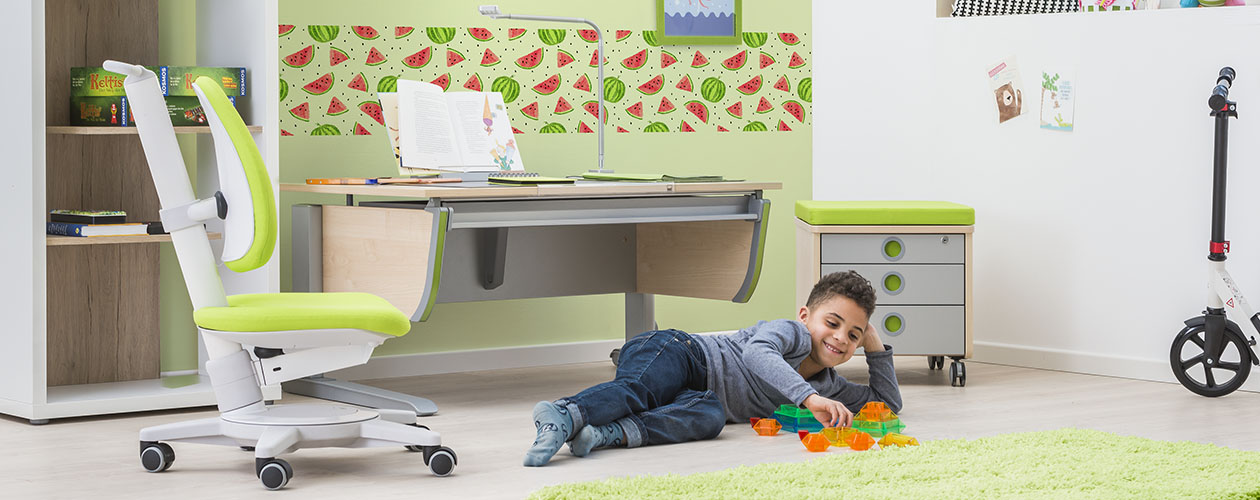
First graders must learn discipline. Timetables, study material, homework, grades and class tests – all these restrict freedom. But maintaining curiosity, the desire to discover, spontaneity and creativity is at least as important. And today more than ever. Because to be ‘fit’ for a society that is characterized by rapid change and complex structures, you need flexibility and the ability to learn new things over and over again.
Therefore, there is little point in just ‘teaching’ children something. It is much more important to maintain their ‘natural learning instinct’ and to support it in order to help them learn actively and independently. Parents can also do this, for example, by creating a good workplace for their child. Because in a learning society, the workplace is increasingly becoming a living space.
The more time you spend with sedentary work, the more important the workplace. What is becoming increasingly common in offices, school children also need at home: an ergonomically designed workplace to create the basis for healthy learning.
The choice of a good workplace is an important consideration. In addition to the determining factors such as the size of the apartment or the children’s room, the availability of storage space and the space at a window, the individual, optimal learning environment must also be taken into account.
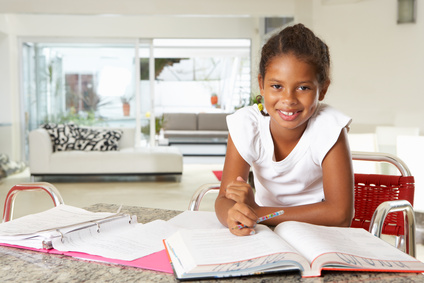
Where should first graders learn? Is the living/dining room suitable as a workplace?
Many primary school children do their homework at the kitchen or dining table. Parents, who also work from home or carry out many written and administrative tasks at the living/dining table, are role models for this. Parents can thus better oversee their child and in addition, kids often do not want to be in a separate room. Furthermore, the spatial conditions in the apartment or house may not be ideal. A workplace in the living room is not a problem in general, as long as some points are taken into account.
It is important that the workplace in the living room is both practical and ergonomic. This means that a desk should be available at the right height and in be sufficient in size. Ideally, there is a children’s desk that grows with the child. A good desk chair, on which you can concentrate for a few hours without back pain, is also important when working in the living room. Under no circumstances should the child work at the coffee table or place an unused kitchen chair at the desk, as problems such as headaches and backaches are inevitable in the long run.
Of course, the workplace in the living room should be well lit. A place at the window is ideal, but even with a good table lamp you can work relaxed. A daylight lamp creates a pleasant working and learning atmosphere with its bright light that resembles sunlight – even in the dark season.
Shelves or mobile containers are ideal for storing folders or other utensils neatly. The right workplace for a school child is more than just a place to learn – it is one of the success factors for a successful school time. Accordingly, the working place should get a lot of attention.
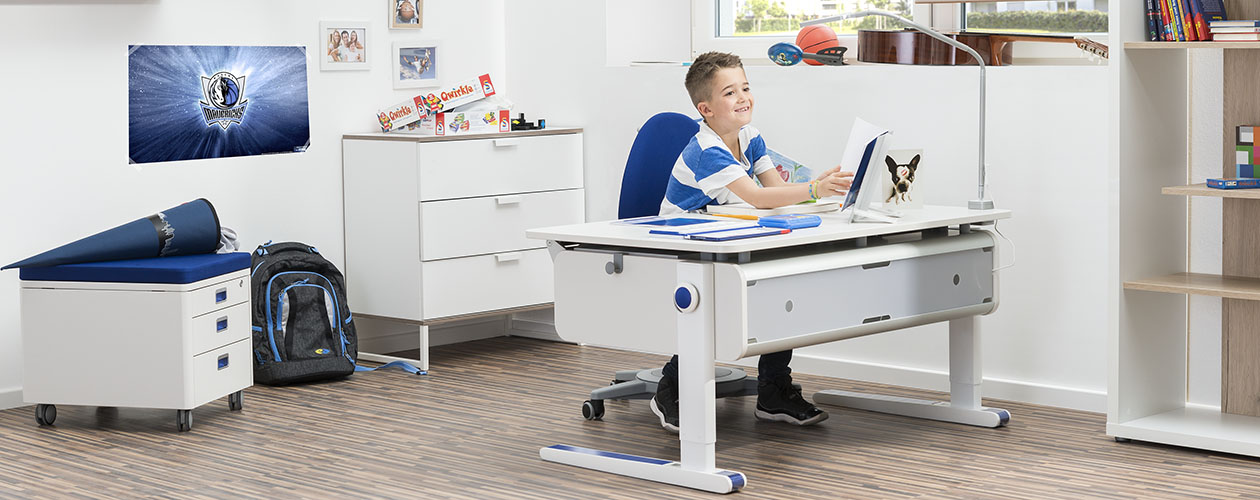
The kids’ own desk as a workstation in the children’s room
The children’s desk in the first grader’s room is certainly the best solution. Here you can create an optimal learning environment. Nevertheless, some children prefer to learn at the living room table rather than at their own desk in the children’s room – this is especially true for children who cannot tolerate a low-attraction learning environment (dead silence!). It can help to leave the door to the children’s room open or to allow the student to quietly listen to music in the background.
For children’s rooms with little space moll also has a suitable solution. The moll ‘Winner’ has two widths of the basic work surface – the optimal desk size for children with 121 cm and an ideal size for a small children’s rooms with the ‘compact’ version of 91 cm.
Even afterwards, various extensions can be used to provide optimum conditions for the different working methods. Children in particular need ergonomic equipment – children’s desks that grow with them not only make ergonomic sense, they are also good to the wallet and the environment. Therefore, the right children’s desk and desk chair are crucial for a good workplace, even for first graders.
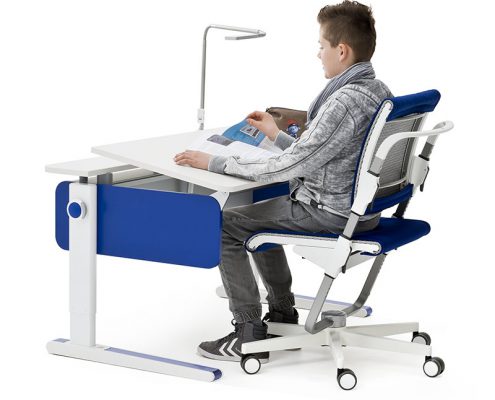
What does the right desk look like?
The child’s work table should not be too small (approx. 80 x 120 cm) and must be height-adjustable. It also makes a lot of sense for the child to be able to tilt the table, especially when reading. Drawers promote order: pencils, exercise books and other utensils can simply be stored there.
Furniture from moll fulfil the criteria established by independent testing institutions such as TÜV Rheinland, Stiftung Warentest or Ökotest, such as ergonomics, adjustable tabletop, rounded edges, scratch-resistant tabletop and much more.
Moll desks bear the GS mark and are awarded the Blauer Engel. Moll also offers long-term guarantees on the quality and offers additional accessories. The Winner children’s desk was last tested by Stiftung Warentest in 2006 and awarded the best grade of 1.7.
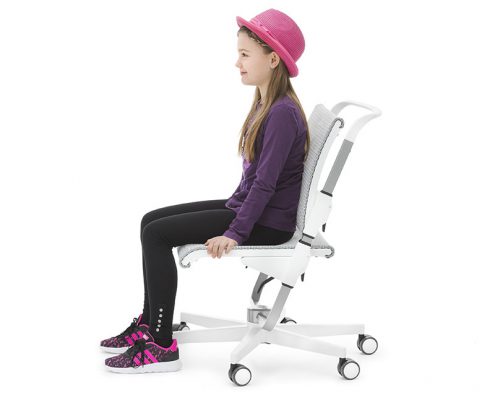
What does the right desk chair look like?
The chair should be adjustable so that it can be optimally adjusted to the different body proportions of the first grader. Not only the height, but also the correct seat depth are important. The chair can thus grow with the child. It goes without saying that the chair should remain stable and non-tilting. The chair should be comfortable and have a pleasant cover: if the student does not feel comfortable in his chair, this also impairs learning performance.
In 2015, Öko-Test has awarded the moll Maximo 15 with the test rating ‘very good’. Of the ten desk chairs for children and young people, which were tested, only one other chair received the highest grade. Tested were in the categories: Handling, ergonomics, safety, materials and practical testing. The moll Maximo 15 was the only chair that achieved the test result ‘very good’ overall in the practical test.
Öko-Test advises the purchase of quality products, as these offer school children a health-promoting workplace due to their good ergonomic properties and high-quality materials – compared to cheap products.
Tipp:
Chair settings and table height should be checked on a regular basis. Children grow rapidly, so that it can quickly happen that furniture becomes too small shortly after school enrolment. With an average growth rate of 7 cm per year, parents should constantly adjust the optimal learning position at the child’s’ workplace.
Brain performance and emotions are closely linked: The better you feel, the better your brain works. It is therefore by no means obsolete to design the student’s workplace in a friendly way with objects such as motivational posters and pictures as well as green plants.
Certain recurring procedures are also part of learning. In this way, routines make the learning life easier, for example by the child first gathering together everything, that is needed at the beginning. When learning is finished, everything should be put away again – every time.
It’s the only way for kids to keep things tidy. If you have to start major tidying up activities before you start learning, you have already wasted a large part of your energy. We have some tips on how to work at your own desk:
Learning routines for kids
- The work surface of the children’s desk is always kept free!
- What has nothing to do with learning should be cleared away before learning!
- After learning, the desk had to be tidied up again.
- A pinboard helps for the planning of class tests.
- The hanging of learning posters at the workplace supports learning.
- The workplace is important for the success at school and should be treated carefully.
- Regularly opening the window for fresh air is good for learning.
- Sitting correctly on a swivel chair that grows with your child helps them to learn.
- Order at the workplace: everything has its fixed place.
- No radio or loud music while learning
Learn more tips on school enrolment from our guide for first graders …..
…. with tips for the time before school enrolment
Learn more tips on school enrolment from our guide for first graders …..
…. with tips for the time after the 1st day of school
